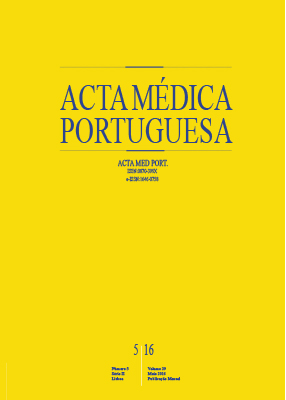Study on Portuguese Medical Schools’ Learning Conditions: A National Analysis on Student Satisfaction, Student-Tutor Ratios and Number of Admissions
DOI:
https://doi.org/10.20344/amp.6795Keywords:
Medical Education, Medical Schools, Medical Students, Portugal, Self-Evaluation Programs.Abstract
Introduction: Experiences of clinical and nonclinical learning environments, as well as assessment and study environments influence student satisfaction with their medical schools. Student-tutor ratios may impact on their perception of clinical learning environments. The aim of this study was to analyze medical students’ satisfaction and student-tutor ratios in relation to medical schools’ number of admissions.
Materials and Methods: A questionnaire was created, regarding learning, assessment and study environments in eight medical schools. 2037 students participated in this cross-sectional study. Cronbach’s alpha (internal consistency) was calculated and principal component analysis was conducted. Pearson correlations and multiple comparisons were analyzed.
Results: Assessment environments showed the highest satisfaction scores and clinical learning environments the lowest scores. The national student-tutor ratio in clinical rotations is 7.53; there are significant differences among schools. Institutions with higher number of admissions showed the lowest scores of overall student satisfaction (r = -0.756; p < 0.05), which decreased with progression in the medical course. High student-tutor ratios are strongly correlated with low levels of satisfaction regarding clinical learning environments (r = -0.826; p < 0.05).
Discussion: Clinical learning environments show the lowest satisfaction scores, which may expose the effect of high ratios in clinical rotations. Depending on the number of admissions, significant differences between medical schools were found. Quality of teaching-learning strategies and articulation with hospitals might also be important variables.
Conclusion: Medical schools with more admissions might be more susceptible to lower scores of student satisfaction. High student-tutor ratios in clinical rotations may reduce the quality of learning experiences and inhibit the acquisition of competences.
Downloads
Downloads
Published
How to Cite
Issue
Section
License
All the articles published in the AMP are open access and comply with the requirements of funding agencies or academic institutions. The AMP is governed by the terms of the Creative Commons ‘Attribution – Non-Commercial Use - (CC-BY-NC)’ license, regarding the use by third parties.
It is the author’s responsibility to obtain approval for the reproduction of figures, tables, etc. from other publications.
Upon acceptance of an article for publication, the authors will be asked to complete the ICMJE “Copyright Liability and Copyright Sharing Statement “(http://www.actamedicaportuguesa.com/info/AMP-NormasPublicacao.pdf) and the “Declaration of Potential Conflicts of Interest” (http:// www.icmje.org/conflicts-of-interest). An e-mail will be sent to the corresponding author to acknowledge receipt of the manuscript.
After publication, the authors are authorised to make their articles available in repositories of their institutions of origin, as long as they always mention where they were published and according to the Creative Commons license.









